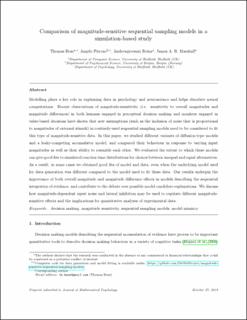Comparison of magnitude-sensitive sequential sampling models in a simulation-based study
Journal article, Peer reviewed
Accepted version
Permanent lenke
https://hdl.handle.net/11250/2764439Utgivelsesdato
2020Metadata
Vis full innførselSamlinger
Sammendrag
Modelling plays a key role in explaining data in psychology and neuroscience and helps elucidate neural computations. Recent observations of magnitude-sensitivity (i.e. sensitivity to overall magnitudes and magnitude differences) in both humans engaged in perceptual decision making and monkeys engaged in value-based decisions have shown that new assumptions (such as the inclusion of noise that is proportional to magnitudes of external stimuli) in routinely-used sequential sampling models need to be considered to fit this type of magnitude-sensitive data. In this paper, we studied different variants of diffusion-type models and a leaky-competing accumulator model, and compared their behaviour in response to varying input magnitudes as well as their ability to resemble each other. We evaluated the extent to which these models can give good fits to simulated reaction time distributions for choices between unequal and equal alternatives. As a result, in some cases we obtained good fits of model and data, even when the underlying model used for data generation was different compared to the model used to fit these data. Our results underpin the importance of both overall magnitude and magnitude difference effects in models describing the sequential integration of evidence, and contribute to the debate over possible model candidate explanations. We discuss how magnitude-dependent input noise and lateral inhibition may be used to regulate different magnitude-sensitive effects and the implications for quantitative analyses of experimental data.

